‘We should have a sense of urgency’ as farm drainage tile drives nutrient pollution
Editor’s note: This is the fifth in a five-story series that will examine the slow progress being made on reducing harmful agricultural runoff from the Mississippi River basin, which causes a low-oxygen “dead zone” in the Gulf of Mexico that threatens wildlife and fisheries.
An increased use of agricultural drainage tile is one reason a 2025 deadline to reduce nitrate and phosphorus entering the Gulf of Mexico by 20% is unlikely.
Drainage tile, a system farmers use to drain water from croplands, is also a contributor to the historic loss of up to about 100 million acres of wetlands in the U.S., researchers say.
This hidden underground pipe system stretches over more than 50 million acres in the U.S., with about 84% of those acres in the upper Midwest. It has become essential to modern agriculture, but it brings devastating environmental consequences.
About 98% of drainage tile in the nation is located in watersheds with excess nitrate and phosphorus levels. Tile changes the natural movement of water, serving as a conduit for pollution that is flushed quickly into nearby waterways.
Drainage tile is the “main delivery mechanism for nitrates from farm fields to the stream network,” said Chris Jones, a retired hydrologist from the University of Iowa.
Before tiles existed, a raindrop might take decades to reach a stream network, Jones said. “Now it’s hours or days.”
And researchers and agriculture industry experts say the problem is only getting worse. As climate change drives wetter weather in the Midwest and farmers push for greater productivity, many observers agree that drainage tile use is increasing.
Yet in many states, tile goes unmonitored and unregulated. Since tiles are considered a nonpoint source of pollution, which comes from places like farms where water isn’t tested, they also fall outside the reach of the Clean Water Act.
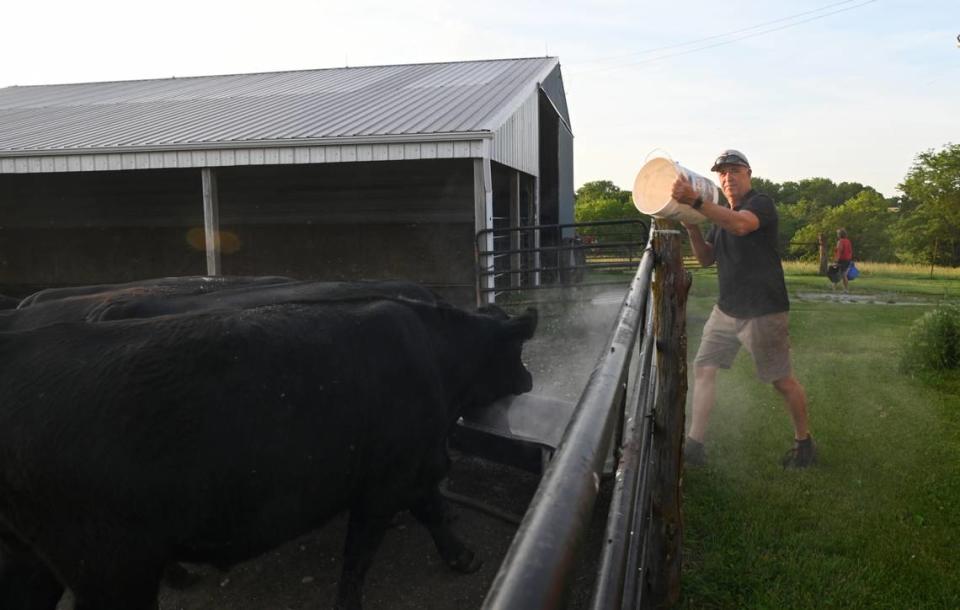
‘Bottom line is we have to make money’
For many farmers, the math is simple. Tile costs about $1,850 to $3,700 per acre, an up-front investment that can increase annual crop yields by 5% to 25%.
Tile installers bury a system of connected drain pipes under farm fields to transport water to an outlet or ditch. The drains suck excess water out of the soil, giving plants room to breathe and allowing farmers to work their fields sooner.
Harold Beach, a farmer in Taylor Township, Missouri, said tile significantly improved his fields and his yields. In a recent video, he and his son, Chris, can be seen driving a tractor that pulls a tile plow along a trench in the middle of a field, feeding long stretches of black pipe into dry soil.
Beach said he does worry about nutrient pollution. But he also feels pressure to successfully maintain his farm, which has been in the family for decades.
“Bottom line is we have to make money to stay here,” he said. “I’ve got past generations looking down thinking, ‘You better do it right.’”
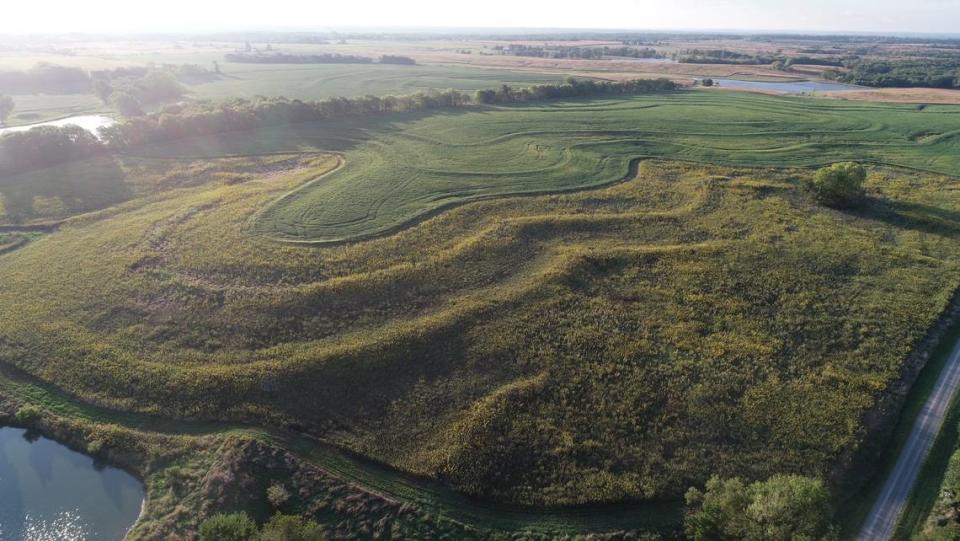
Unregulated tile growth, disappearing wetlands
Settlers have been draining the land since the 1800s. John Johnston, a Scotsman with a farm in upstate New York, found dense, wet, mushy clay when he first stuck his shovel in dirt in 1838. He knew it was holding too much moisture, waterlogging his crops and reducing his yields, so he laid thousands of clay pipes by hand to drain the excess water.
Johnston’s yield increased from five bushels of wheat per acre to 50 bushels per acre. Soon after, agriculturalists from all over the world wrote to him asking for advice and information. He answered each letter and published articles, inspiring farmers. By the late 1800s, clay tiles were being mass produced. Drainage tile was embedded into the nation’s soil – and its history.
By the 20th century, a quarter of U.S. wetlands had been drained for agricultural use. Once including a 1,500 square-mile stretch called the “Great Black Swamp” in Ohio and Indiana, the Midwest now has less than 5% of its original wetlands left.
One of the few federal laws that could govern drainage tile is the “Swampbuster” provision of the Food Security Act. Since 1985, it has prohibited farmers participating in USDA programs from converting wetlands into farmland.
But the law may have come too little, too late. Besides the fact that the provision doesn’t apply to farmers not following USDA programs, many wetlands were already drained in the nineteenth century for agricultural use.
And wetlands are still disappearing — a 2019 U.S. Fish & Wildlife Service report found that over 220,000 acres of wetlands were lost in the contiguous U.S. between 2009-2019.
A few states, like South Dakota, Wisconsin and Minnesota, delegate regulation of drainage tile to local authorities. In other states, like Missouri and Iowa, there are no permitting requirements to install drainage tile.
“The local officials have no appetite or inclination to start a permitting process,” said John Torbert, executive director of the Iowa Drainage District Association.
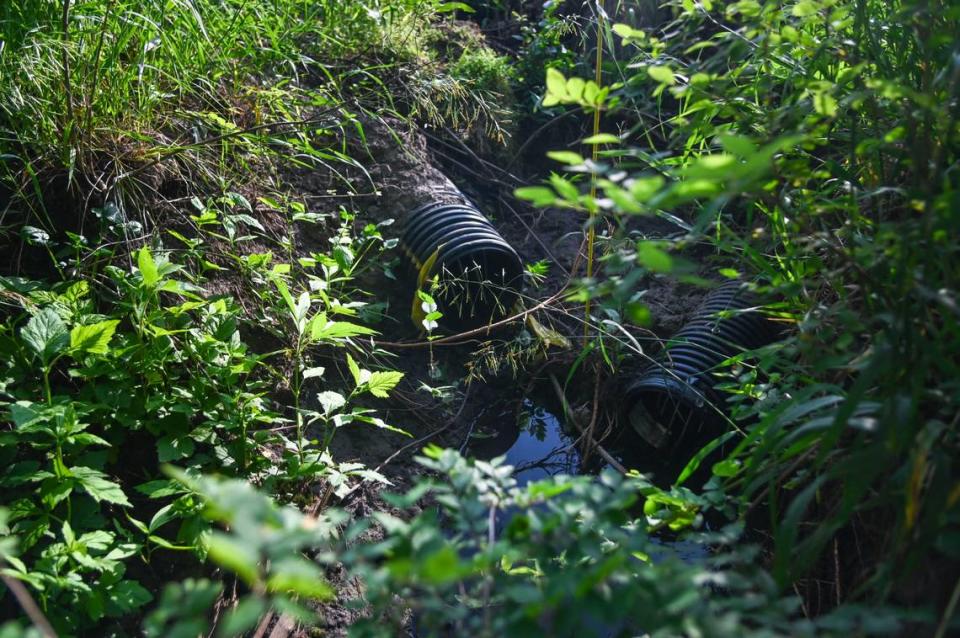
‘A direct shot into the streams’
Tile is a major influence on the massive amounts of nitrate that flow into the Gulf of Mexico.
About 90% of this nitrate comes from the Mississippi and Atchafalaya rivers, which are connected to highly tiled states like Minnesota, Iowa, Illinois, Indiana and Ohio. Researchers say future precipitation changes may increase nitrate loads in some cases.
Excess nutrients spur surplus plant and algae growth, which can degrade water quality and deprive other organisms of oxygen. One 2010 study found that tile drains contributed up to 90% of annual nitrate and heavy metal loads from an experimental field to an outlet.
Other chemicals, like PFAS (also called “forever chemicals”) and microbial contaminants from manure can also be transported through tile.
Dana Kolpin, research hydrologist with the U.S. Geological Survey’s Central Midwest Science Center, said tile effectively mainlines contaminants. “They now get basically a direct shot into the streams,” he said.
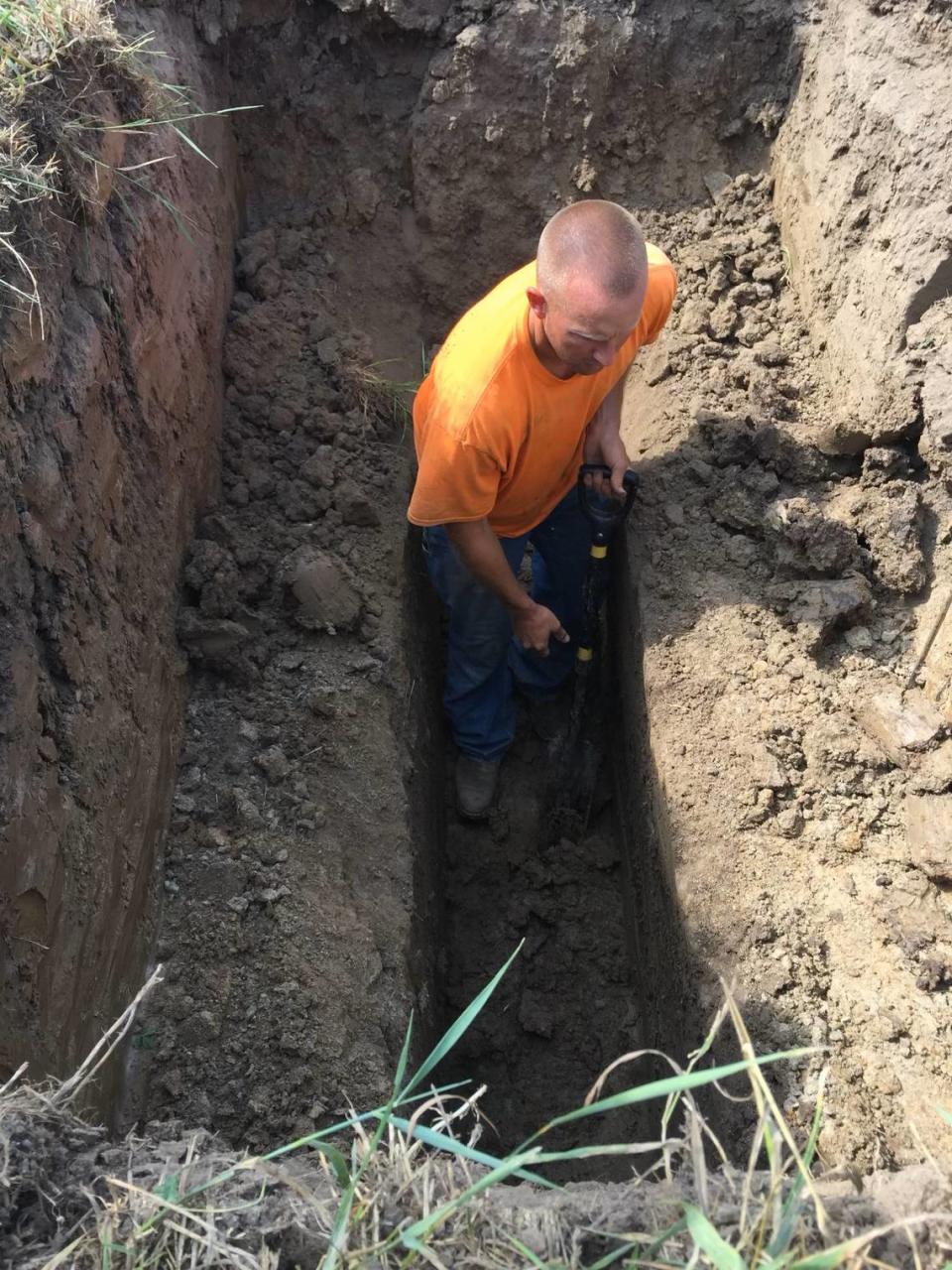
Is conservation drainage a solution?
Some researchers say new technology can reduce nutrient pollution. Laura Christianson, a researcher in the Department of Soil, Water and Climate at the University of Minnesota, points to bioreactors and saturated buffers as possible options.
Bioreactors use a wood chip-filled trench to filter nitrate out of water from tile. Buffers redirect the water through shrubbery to denitrify it. Both reduce the amount of nitrate going into streams.
One study suggested that in about two-thirds of sub-watersheds with high amounts of nitrate, conservation methods on and around farm fields may be the best way to reduce excess runoff.
But others say this is a losing game. The Iowa Environmental Council, a nonprofit environmental coalition, found it would take up to 22,000 years to achieve the state’s nutrient reduction plan goals at the current pace of conservation project installation.
“Those have not been implemented at a scale that offsets the continued installation of tiled drainage,” said council staff attorney Michael Schmidt.
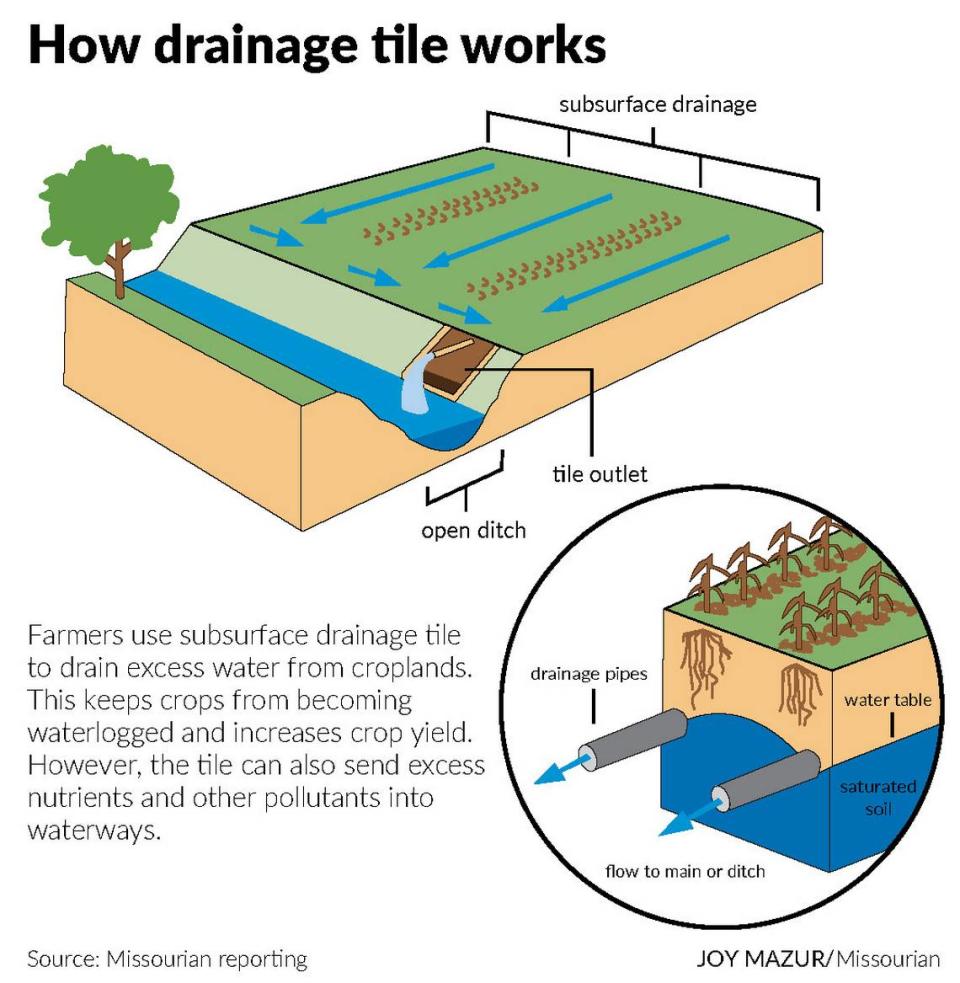
‘We’re responsible for it’
The way hydrologist Jones sees it, conservation practices work, but there never will be enough to solve the problem. He estimates that one bioreactor treats 40 acres of tile-drained land and costs $15,000 to install, while Iowa has 26 million crop acres.
“We could cut down every tree in Iowa, and we wouldn’t have enough wood chips to make all the bioreactors that we need. Nowhere close,” Jones said. “So these really aren’t what we call landscape-scale solutions. They’re sort of Band-Aids that work at the field scale, but they’re not a real policy solution.”
Jones said a real policy solution would be for farming to move away from practices that put pollutants into waterways altogether.
Farmer Doug Doughty, who raises soybeans, corn and livestock in Livingston County, Missouri, is increasingly concerned about nutrient pollution from farmland.
He has built terraced fields, where crops are sectioned out so that some are on higher ground than others. These slopes slow water down as it heads from the field into the underground tile system, reducing soil erosion and nutrient runoff.
At age 66, Doughty hopes to preserve the health of his land – and the environment – for the next generation.
Doughty has soberly watched the news about increasing Midwestern cancer rates, drinking water contaminated with farm chemicals, and the “dead zone” in the Gulf of Mexico caused by agricultural runoff.
“It is obvious that we have a problem here. We’re responsible for it, and we should have more of a sense of urgency when it comes to nutrients leaving our fields,” Doughty said. “There are a lot of good practices out there. And there are farmers that are really working on reducing erosion and reducing nutrient pollution. But it’s not enough yet. It’s not enough because the problem is increasing.”
This story is part of the series Farm to Trouble from the Mississippi River Basin Ag & Water Desk, an independent reporting collaborative.
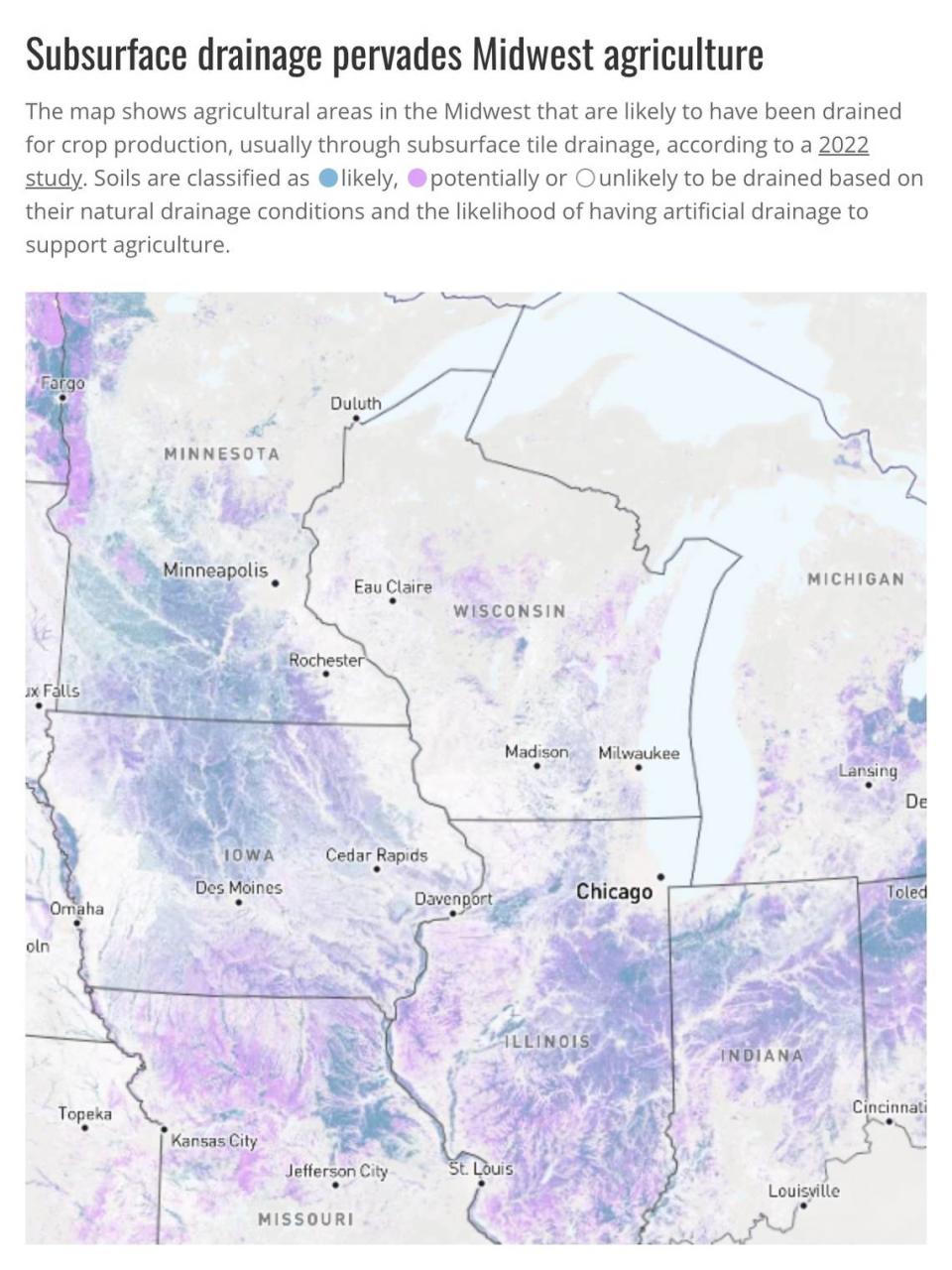
Farm to Trouble: As conservation lags, so does progress in slashing Gulf’s ‘dead zone’
Louisiana bears the burden of Mississippi River runoff. Why doesn’t it push for solutions?
Not just a Gulf of Mexico problem: Mississippi River farm runoff pollutes upstream waters
Could Mississippi River benefit from Chesapeake Bay’s strategy to improve water quality?

